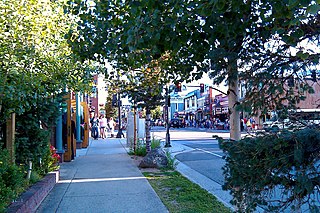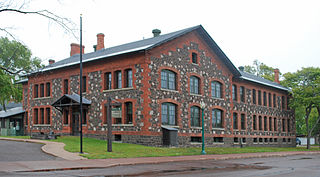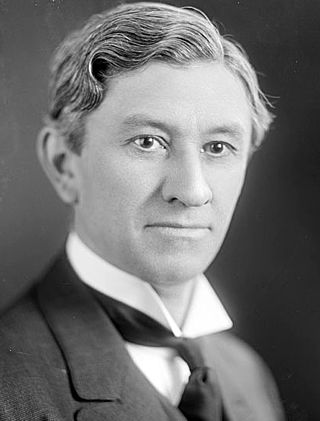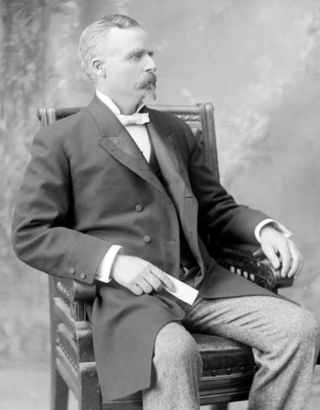
The City of Sheridan is a home rule municipality located in Arapahoe County, Colorado, United States. Sheridan is a part of the Denver–Aurora–Lakewood, CO Metropolitan Statistical Area. The population was 6,105 at the 2020 census.

Breckenridge is the home rule municipality that is the county seat and the most populous municipality of Summit County, Colorado, United States. The town population was 5,078 at the 2020 United States Census. Breckenridge is the principal town of the Breckenridge, CO Micropolitan Statistical Area. The town also has many part-time residents, as many people have vacation homes in the area. The town is located at the base of the Tenmile Range.

Hydraulic mining is a form of mining that uses high-pressure jets of water to dislodge rock material or move sediment. In the placer mining of gold or tin, the resulting water-sediment slurry is directed through sluice boxes to remove the gold. It is also used in mining kaolin and coal.

John Robert Mortimer was an English corn-merchant and archaeologist who lived in Driffield, East Riding of Yorkshire.

James Hamilton Peabody was the 13th and 15th Governor of Colorado, and is noted by some for his public service in Cañon City and by others for his brutality in crushing the miners' strike in Cripple Creek in 1903–04.

Keweenaw National Historical Park is a unit of the U.S. National Park Service. Established in 1992, the park celebrates the life and history of the Keweenaw Peninsula in the Upper Peninsula of the U.S. state of Michigan. It is a federal-local cooperative park made up of two primary units, the Calumet Unit and the Quincy Unit, and almost two dozen cooperating "Heritage Sites" located on federal, state, and privately owned land in and around the Keweenaw Peninsula. The National Park Service owns approximately 1,700 acres (690 ha) in the Calumet and Quincy Units. Units are located in Baraga, Houghton, Keweenaw, and Ontonagon counties.

The Denver Museum of Nature & Science is a municipal natural history and science museum in Denver, Colorado. It is a resource for informal science education in the Rocky Mountain region. A variety of exhibitions, programs, and activities help museum visitors learn about the natural history of Colorado, Earth, and the universe. The 716,000-square-foot (66,519 m2) building houses more than one million objects in its collections including natural history and anthropological materials, as well as archival and library resources.
Arapahoe was one of the first settlements in what is now the U.S. state of Colorado. Nothing remains of the now deserted ghost town in Jefferson County, except a historical marker on the south side of 44th Avenue, between the towns of Golden and Wheat Ridge.

Benjamin Clark Hilliard was an American lawyer, jurist, and politician. He served two terms as a U.S. Representative from Colorado, and was a two-time chief justice of the Supreme Court of Colorado.

Martha Ann Maxwell was an American naturalist, artist and taxidermist. She helped found modern taxidermy. Maxwell's pioneering diorama displays are said to have influenced major figures in taxidermy history who entered the field later, such as William Temple Hornaday and Carl Akeley. She was born in Pennsylvania in 1831. Among her many accomplishments, she is credited with being the first woman field naturalist to obtain and prepare her own specimens. She was inducted into the Colorado Women's Hall of Fame in 1985.
Citizens' Alliances were state and local anti-trade union organizations prominent in the United States of America during the first decade of the 20th century. The Citizen's Alliances were closely related to employers' associations but allowed participation of a broad range of sympathetic citizens in addition to those employers apt to be affected by strikes. Originating in the American state of Ohio as the "Modern Order of Bees," the Citizens' Alliance movement spread westwards, playing a particularly important role in labor relations in the states of Colorado and California. Citizens' Alliance groups often worked in tandem with smaller but better financed employers' organizations interested in establishing or maintaining open shop labor conditions, including the Mine Owners' Associations (MOA) or the National Association of Manufacturers (NAM).

John Francis Campion was a wealthy Canadian-American who made his fortune in mining and sugar production. He was also an executive and investor in banking, railroad, insurance, and other businesses.

Mount Sniktau is a high mountain summit in the Front Range of the Rocky Mountains of North America. The 13,240-foot (4,036 m) thirteener is located in Arapaho National Forest, 1.6 miles (2.5 km) northeast of Loveland Pass in Clear Creek County, Colorado, United States.

James Harvey Crawford (1845-1930) was the founder of Steamboat Springs, Colorado. He was a man of many vocations: soldier, farmer, pioneer, cattleman, miner, land developer, and politician. He was called the "Father of Steamboat Springs", and his wife Margaret Emerine (Bourn) Crawford was called the "Mother of Routt County".

Wilmatte Porter Cockerell was an American entomologist and high school biology teacher who discovered and collected a large number of insect specimens and other organisms. She participated in numerous research and collecting field trips including the Cockerell-Mackie-Ogilvie expedition. She wrote several scientific articles in her own right, co-authored more with her husband, Theodore Dru Alison Cockerell, and assisted him with his prolific scientific output. She discovered and cultivated red sunflowers, eventually selling the seeds to commercial seed companies. Her husband and her entomological colleagues named a number of taxa in her honor.

Elizabeth Piper Ensley, was an educator and an African-American suffragist. Born in Massachusetts, Ensley was a teacher on the eastern coast of the country. She moved to Colorado where she achieved prominence as a leader in the Colorado suffrage movement. She was also a journalist, activist, and a leader and founder of local women's clubs.

John and Elizabeth Tallman settled in Pine Grove of Colorado Territory, present-day Parker, Colorado, in 1866. They were among the early settlers in Douglas County, Colorado, with John working as a cattle rancher, sawmill hand, county clerk, and businessman. John and Elizabeth ran the Elizabeth Hotel in the late 1890s. She also wrote of her experiences with Native Americans and observations of warfare among the Cheyenne, Arapaho, and the Utes.

Henrietta Bromwell (1859–1946) was an artist, author, and a socialite from Denver. She is known for her landscape paintings and literature. She was a co-founder of the Artists' Club of Denver, which led to the founding of the Denver Art Museum. She taught oil and watercolor painting in downtown Denver and was an organizer and jurist at local art exhibitions. Bromwell was a genealogist, with multiple volume publications, and a publisher of her and her father's works.
Thomas Carr is an American archaeologist and photographer who has studied the intersection of anthropology and art with an emphasis on the abandonment of human built environments in the natural landscape. His academic work has been published in journals such as Archaeological Prospection and Colorado Heritage Magazine. He has lectured extensively on archaeology, photography, visual ethnography, and historic preservation. His photographic work in the Rocky Mountains region has been the subject of several major exhibitions and numerous group and juried exhibitions. The Western History and Genealogy Department of the Denver Public Library holds a collection of Carr's photographs in its permanent archives.

















